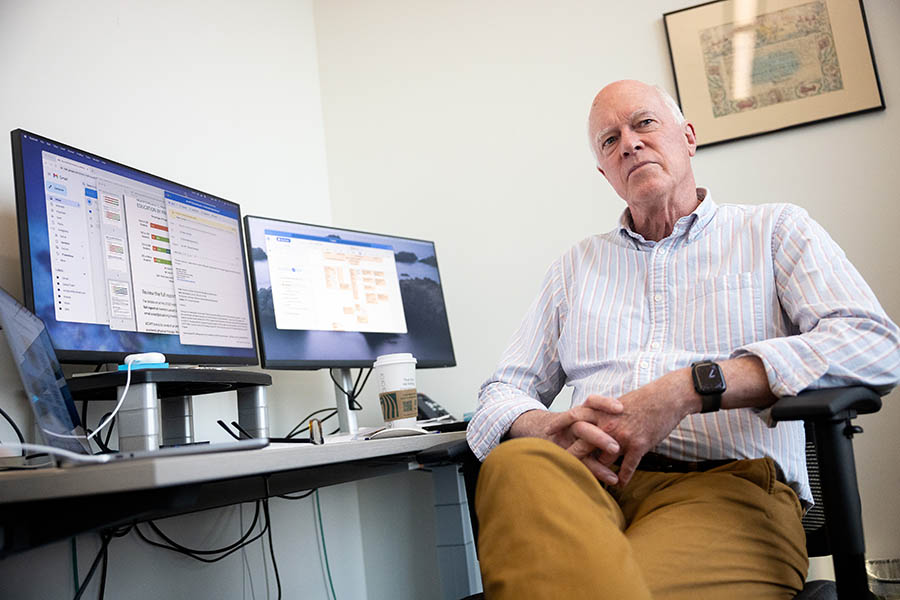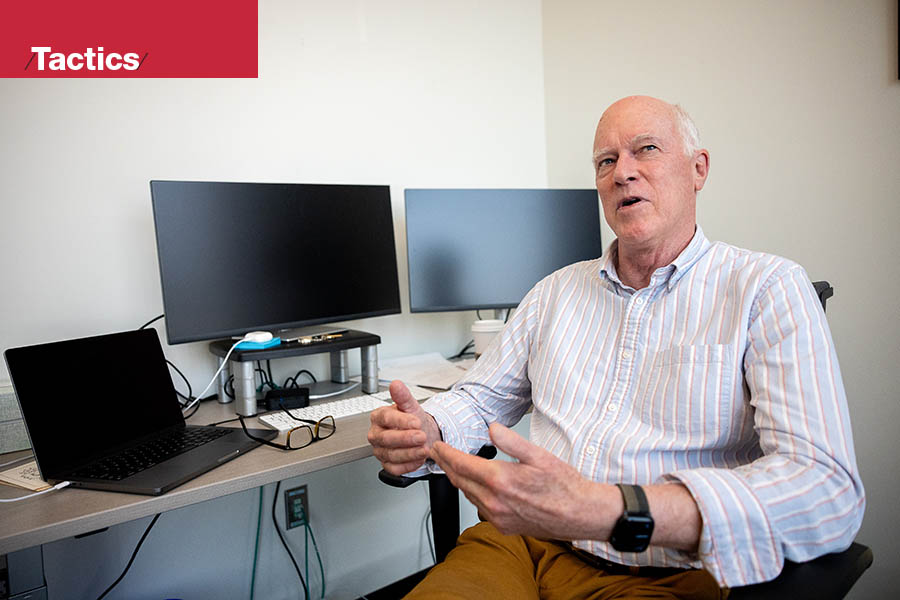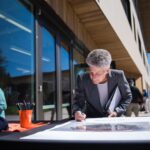OSU-Cascades’ new chancellor and and dean talks about the challenges that lie ahead for OSU’s Bend campus.
Last spring Oregon State University announced its fastest-growing branch, Bend’s OSU-Cascades, had a new chancellor and dean at the helm, but Sherman “Sherm” Bloomer, who started the job in May, was no stranger to Oregon’s largest university.
As a marine geologist by academic training, Bloomer, now 69, earned a doctorate in earth sciences from the Scripps Institution of Oceanography in San Diego before teaching at Duke and Boston universities, eventually coming to Corvallis for the “bigger and better” marine geology group. While there he conducted ocean research expeditions, raised $1 million in grants and contracts, and rose to become OSU’s Dean of the College of Science, where he stayed for 11 years. He then left academia to run the university’s $1.5 billion budget-planning office as an associate vice president.
Bloomer helped write the proposal to bring a four-year branch to Bend that opened on 10 acres in 2016. He replaced Andrew Ketsdever who served as interim vice president after OSU-Cascade’s first top official, Becky Johnson, was tapped to run the entire university system. Ketsdever left OSU to become Dean of Engineering at California State Polytechnic University-Pomona.
Bloomer steps into a role that will largely be defined by his ability to help the university build out the infrastructure needed to grow enrollment, ultimately to around 5,000 students, up from about 1,300 in fall 2022. The first cohort of the branch’s first doctorate program, in physical therapy, will be graduating in the spring 2024. Meanwhile, in October workers broke ground on a $21.6 million, 22,500-square-foot “student success center.” The university also has plans to remediate 24 acres of adjacent land, a former pumice mine and landfill, into a building-ready plot slated for a 500,000-square-foot public-private innovation district, the first of its kind on a university campus in Oregon.
But serious challenges remain. Salem recently awarded about $227 million for university construction projects across the state, but OSU’s biggest ask — $45 million of the $60 million needed to build a health and recreation center — went unanswered.
“It’s probably our biggest challenge right now,” Bloomer says. “How do we get the physical infrastructure built out to keep up with the student growth we’re trying to create? One of the strengths of higher education is that you’re in it for the long view.”
Bloomer sat down with Oregon Business to talk about those challenges, trends in higher education in Oregon today and the branch’s green-energy goals.
This interview has been edited for space and clarity.

It’s been a few months since May 1, your first day. How are you settling in?
I am mostly working and meeting people and slowly getting familiar with Bend neighborhoods and mastering roundabouts. It’s a fully packed calendar, but what an incredibly welcoming community. Everyone has been very engaged in wanting to see OSU-Cascades be successful. I’ve been struck by how many really love working here and how committed members of the community have been — some of them for 40 years.
Now you have an opportunity to help channel that commitment. What’s your vision?
I don’t need to craft a new vision. I see myself continuing one that the university created, and particularly Becky Johnson. OSU is a very visible, very successful, very prominent national research and land-grant university, and we’re bringing that brand here but around the needs in the community.
What does that look like?
For one, we’re creating an innovation district and it is really different and powerful, and the reason I took the job. It’s a space where you intentionally bring in private-sector partners that can engage people and activate that space. It’s not just offices but places to eat, shop and maybe some entertainment. We’re trying to support folks in those early phases of entrepreneurship, so they can hopefully grow and get large enough to find space someplace else in the city. The vision is to build a resource for people who don’t know how to get capital or how to manage a startup, maybe in outdoor products or tech. We’re also keeping a real eye on the workforce needs in Central Oregon, what’s going to help the economy grow and what our role is as a catalyst.
I just walked through a building that harnesses geothermal energy on-site. How far are you on your net-zero energy goals?
In the end, one of our goals is to be net zero in energy, water and waste, and we have a chance to kind of be a demonstration project for that. It’s really hard to retrofit a 100-year-old building, but we’re building from the ground up. Part of the purpose of the innovation district is to think about how to handle wastewater and sewage. Waste is the hardest one because it’s a highly distributed function across all your employees and all your students. But universities, of all places, ought to be able to think innovatively about this.
What about leadership here? Do you have plans to change the structure?
I’ve got a number of people in interim leadership roles, so we’re working on what our permanent leadership structure should look like. The biggest change isn’t a change in management. It’s more clarity on the idea that we’re part of OSU. It’s one entity. The success of OSU-Cascades is a university priority. That’s always been true, but it’s not always been clear. That lets us take advantage of the fact that OSU-Cascades is not starting from zero but is a part of a very successful, very visible, very established university.
Meanwhile, OSU-Cascades didn’t get state help funding a new health and recreation facility. What’s plan B?
We’re learning what the options are to diversify the funding mix. Are there private partners that might be interested? Philanthropy? And how do we build a stronger case to the state? We’re going to build the building at some point. A different strategy would be helpful. I don’t know what that strategy looks like.
Before becoming chancellor, you ran the university’s $1.5 billion budget-planning office. How would you describe your work there?
It was an opportunity to learn the other half of how universities work. The business folks don’t necessarily understand the work that faculty do. The faculty worries about things that don’t make sense to the business side. A lot of my work would be policy and making the budget more visible and understandable: How does it work? What’s driving decisions? I had a very talented financial guy, so I didn’t do any of that.
What’s your take on enrollment trends post-pandemic?
Nationally, the number of high school graduates is declining, and the way that seems to be playing out post-pandemic is large flagship universities are seeing modest to really strong enrollment growth while smaller universities, the 1,000- to 2,000-student universities, are struggling. We’re not competing with each other — more than half of our students come from Central Oregon — the problem is there aren’t enough students going on to higher education. One of the things I think that the seven public universities need to think about is how do we together increase the participation rate of high school graduates going on to college?
You’ve been involved with both public and private universities. What made you stick around for so long at OSU?
Both Duke and Boston University were big, private, very successful universities with excellent students, but there was a bigger and better group of marine geologists at OSU. But the reason I stayed at OSU is because I found the public university mission really much more rewarding. The idea that the university is there to serve the people of Oregon is something almost all the people I know who work here take really seriously. It was wonderful to teach students at Duke, but you’re teaching a certain kind of student and a narrower slice of students. Here we admit every qualified Oregonian, and having admitted them, we try to get every single one of them graduated. That’s a very fulfilling mission.
I hear you come from a family of five sisters. Tell me about growing up.
Yes, five younger sisters. I grew up in upstate New York, in a small town in an agricultural county right under Lake Ontario. We had a football team, but I wasn’t good enough, so I picked up soccer. I learned to play because of the love of the game. So I talked to my colleagues here, and when we build athletic fields, the first thing we’re going to do is paint soccer lines.
Is there anything you’d like to add?
OSU has been in Corvallis forever, it’s been part of the community forever. It’s not the same sense as here,x where we’re creating something new, and that level of active engagement. People advocate for us, help us with financing, help introduce me to people in the community who might be interested in being part of the innovation district. I don’t have just my staff, I have all of these people in the community who actively want to help us be successful. Most places don’t have that in the same way.
Click here to subscribe to Oregon Business.




